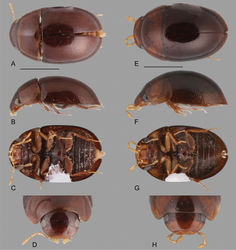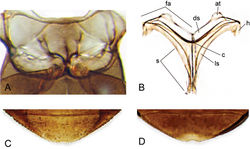Nanosaphes hesperus
| Notice: | This page is derived from the original publication listed below, whose author(s) should always be credited. Further contributors may edit and improve the content of this page and, consequently, need to be credited as well (see page history). Any assessment of factual correctness requires a careful review of the original article as well as of subsequent contributions.
If you are uncertain whether your planned contribution is correct or not, we suggest that you use the associated discussion page instead of editing the page directly. This page should be cited as follows (rationale):
Citation formats to copy and paste
BibTeX: @article{Girón2018ZooKeys, RIS/ Endnote: TY - JOUR Wikipedia/ Citizendium: <ref name="Girón2018ZooKeys">{{Citation See also the citation download page at the journal. |
Ordo: Coleoptera
Familia: Hydrophilidae
Genus: Nanosaphes
Name
Nanosaphes hesperus Girón & Short, 2018 sp. n. – Wikispecies link – ZooBank link – Pensoft Profile
Type material examined
Holotype (male): “SURINAME: Sipaliwini District/ 2°10.521'N, 56°47.244'W, 228 m/ Camp 1, on Kutari River; leg. Short/ & Kadosoe; forest stream/ 20.viii.2010; SR10-0820-01A/ 2010 CI-RAP Survey” (NZCS). Paratypes (38): GUYANA: Region IX: “2°06.492'N, 59°13.653'W, 274 m/ Parabara, N. side of river/ small flowing forested creek/ detritus margins & leaf packs/ leg. Short, Isaacs, Salisbury/ 3.xi.2013; GY13-1103-02A” (1, SEMC); Region VI: “4°09.143'N, 58°11.207'W, 105 m/ Upper Berbice, c. 1 km W/ Basecamp 1; washing sand/ banks; leg. A. Short; 22.iv.2014/ GY14-0921-03E” (1, SEMC); “margins of creek/ leg. Short, Salisbury, La Cruz/ 22.iv.2014/ GY14-0921-03H” (1, SEMC). SURINAME: Sipaliwini District: “2°21.776'N, 56°41.861'W, 237 m/ Camp 3, Wehepai; leg. Short &/ Kadosoe; sandy forest creek/ 4–6.ix.2010; SR10-0904-01A/ 2010 CI-RAP Survey” (19, SEMC); same, except “small stream/ 5.ix.2010; SR10-0905-01A” (1, SEMC); same, except “2°10.521'N, 56°47.244'W, 228 m/ Camp 1, on Kutari River/ Short & Kadosoe; forest stream/ 19.viii.2010; SR10-0819-02A” (1, SEMC); same, except “20.viii.2010; SR10-0820-01A” (8, SEMC); same, except “2.97731°N, 55.38500°W, 200 m/ Camp 4 (low), Kasikasima; sandy/ stream on trail to METS camp/ 20.iii.2012; SR12-0320-02A/ leg. A. Short; 2012 CI-RAP Survey” (3, SEMC, including DNA voucher SLE485); “04°40.966'N, 56°11.262'W, 96 m/ Raleighfallen Nature Reserve/ plateau below Voltzberg; rock pool/ leg. A. Short, Maier & McIntosh/ 28.vii.2012; SR12-0728-01F” (1, SEMC); “04°40.910'N, 56°11.138'W, 78 m/ Raleighfallen Nature Reserve/ Voltzberg trail; margin of stream/ leg. C. Maier & V. Kadosoe/ 30.vii.2012; SR12-0730-01A” (1, SEMC); Raleighfallen Nature Reserve, 17.iii.2016, leg. Girón, SR16-0317-04A (1, SEMC, DNA voucher SLE1070).
Differential diagnosis
Nanosaphes hesperus (Fig. 16E–H) can be easily recognized by its smooth elytra (as opposed to rather coarsely punctate as in N. punctatus, see Fig. 15E, F), and the coloration pattern along the body, with brown elytra, yellow pronotum and brown head with orange clypeus (as opposed to uniform brown coloration along the body as in N. castaneus, or uniformly dark brown head (including the clypeus) as in N. tricolor, see Fig. 16D). Furthermore, it differs from the remaining known species by the sharp, strongly elevated, and pointed carina on the mesoventrite (as opposed to weakly elevated).
Description
Body length 1.3–1.5 mm, width 0.7–0.9 mm. Body elongate oval, weakly convex, with brown head, orange clypeus, yellow pronotum and brown elytra (Fig. 16E–H). Dorsal surface shallowly punctate. Posterior elevation of mesoventrite sharply carinate. Pubescence of ventral surface scanty. Aedeagus (Fig. 18B) with basal piece 0.35-times the length of parameres; parameres as long as median lobe, with narrowly round apex; gonopore situated near apex of median lobe.
Etymology
Named in reference to the gradation of orange to brown colorations along the body of the beetles, which resembles the colors of the sunset, with the Latin word hesperus meaning evening.
Distribution
Guyana, Suriname. Elevation range 105–228 m. See Fig. 19.
Biology
This species has been collected along the margins of forested streams (see Fig. 20A, C, D.
Original Description
- Girón, J; Short, A; 2018: Three new genera of acidocerine water scavenger beetles from tropical South America (Coleoptera, Hydrophilidae, Acidocerinae) ZooKeys, (768): 113-158. doi
Images
|





